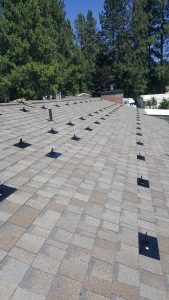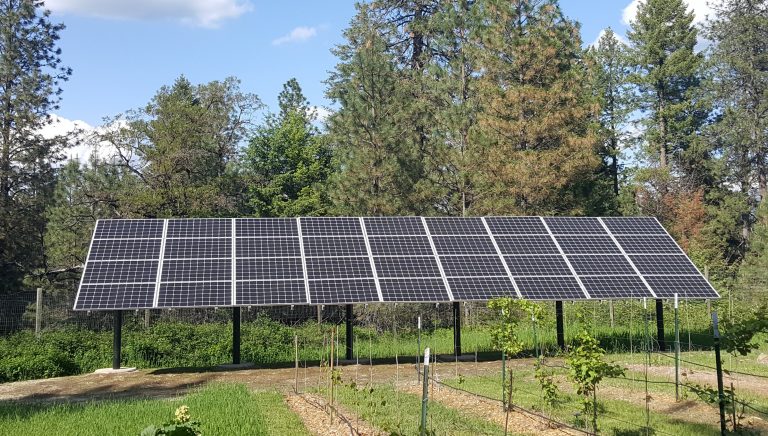 The Solar Age has clearly reached the Inland Northwest. Although the area has had a smattering of small solar projects for decades, the past two years have seen an explosion of new companies and larger systems. For a look at what is coming, just travel a bit — to almost anywhere. As costs drop and climate needs grow, solar is sweeping the world.
The Solar Age has clearly reached the Inland Northwest. Although the area has had a smattering of small solar projects for decades, the past two years have seen an explosion of new companies and larger systems. For a look at what is coming, just travel a bit — to almost anywhere. As costs drop and climate needs grow, solar is sweeping the world.
If you’re thinking of catching this wave, you now have a brief opportunity to make the move to solar with enormous help from the U.S. Government and the State of Washington, although you’ll need to move quickly.
Here are a few things to keep in mind when going solar yourself:
NOTE TO RECENT READERS OF THIS POST: ON FEBRUARY 1, 2019 THE WASHINGTON RENEWABLE ENERGY SYSTEM INCENTIVE PROGRAM CLOSED TO NEW APPLICANTS. HOWEVER, THIS DOES NOT AFFECT OTHER STATE AND FEDERAL INCENTIVES THAT ARE STILL FULLY AVAILABLE AS OF FEBRUARY 2019.
The Dollars and Cents
A typical suburban Spokane family home using around 15,000 kilowatt-hours per year will spend around $36,000 after taxes for a high-quality 12 kW system that cuts utility bills to nearly nothing. Given a sunny rooftop, 80% of that cost can be recovered with government incentives, leaving a net cost of $7,200—which lowered utility bills will equal in about seven years, with huge savings beyond. Better still, systems recoup most of their costs in improved property value the minute they are installed.
The basic drivers of financial return fall into five categories that, combined, typically recover system cost in short order and provide handsome savings for decades:
- The federal Investment Tax Credit: Pays 30% of your system’s cost, taken as a deduction on income tax. If that 30% of the system cost exceeds your taxes owed, you can save the remainder to deduct in the following year and possibly beyond.
- Washington State’s Renewable Energy System Incentive Program: Pays 50% of your system’s cost, or makes payments for eight years, whichever comes first. For a residence using Washington-made panels, you are paid in annual checks at the rate of 18 cents per kilowatt-hour for the power your system produces. NOTE: ON FEBRUARY 1, 2019 THIS PROGRAM CLOSED TO NEW APPLICANTS.
- Washington State’s Net Metering Program: Allows you to credit excess power fed to the grid against utility bills within the same fiscal year (which begins April 1), typically crediting high summer production against winter bills.
- Increased property value: National laboratory studies show that solar power systems typically recover most or all of their cost in higher property resale value.
- Protection against utility rate hikes: With utility rates rising over time at 2 percent or more annually, you can benefit by locking in lower costs with a system you own, especially if you plan to stay in your home for more than ten years.
As you see, it’s easy to confuse the two Washington State programs. However, they are very different incentives created at different times. The Renewable Energy System Incentive Program is a “production incentive” that pays you for all the power your system cranks out. The Net Metering Program is simply a law that commands utilities to credit you for excess electricity that you send back to the grid, using your summer surplus to cut your winter power bills.
Time is Running Short
Access to the state production incentives may indeed end soon. Once your system is certified, you lock-in the incentives outlined above, which pay up to half the cost of your system over eight years. But don’t delay; after ordering, it takes an average of six weeks to get a good system built and certified for the state production incentives. About 80% of the $110 million allocated by the legislature last year has now been reserved for projects, and access to the remainder probably won’t last more than a few months. August alone saw $10 million of these funds committed to new systems. The better installers are in demand, and it is likely that we’ll see a rush to build systems this fall. Although the legislature may renew these incentives next year, or funding may come through Initiative 1631 if that wins in November, those outcomes are very uncertain.
Even if the legislature renews funding, another deadline looms on June 30, when state production incentives for new systems drop from 18 cents to 15 per kilowatt-hour, if you use Washington-made modules, for systems certified after that date.
Meanwhile, the 30% Federal Investment Tax Credit for new systems remains in place, declining to to 26% in 2020.
No Batteries Required
Nearly all solar installations in metro Spokane are grid-tied, with no battery needed.
Why? Because Washington State financial incentives only pay for grid-tied systems, and because batteries remain costly. It appears that you can still capture the 30% Federal Investment Tax Credit if the battery is upstream from the inverter, but good, lithium-ion batteries for grid-connected home use still start at around $8,000, even after that incentive. Also, we have no time-of-use electricity pricing in our state, unlike California and New York where it pays to store power when it’s cheap and discharge your battery when power rates are higher during peak demand hours. In utility speak, this “demand response” pricing is much discussed, but no one knows when it will arrive here. Although one or two local companies build both on-grid and off-grid systems, most just stick to the grid because that’s where the state incentives are.
The Equipment
- Modules (aka “Panels”)
- Nearly everyone in Washington uses ITEK 300s, because they are the only brand made in large quantities in Washington, and Washington State incentives pay you 4 cents per kilowatt-hour for power from panels made here. Bellingham-made ITEKs are quality products, warrantied 12 years for workmanship and 25 for power production (production degrades around 0.3% per year, so your modules are guaranteed to generate at least 80% of nameplate capacity at year 25).
- Optimizers
- These small, rugged processors attach to each module, regulating voltage, communicating with one another and the central inverter. They mitigate shade effects, so that if a couple of panels get shaded by a tree, that won’t fool the inverter into thinking that all modules should be throttled back to the same low production level—which used to be a serious concern for most systems.
- Inverters
- Because your modules produce direct current (DC) electricity, you’ll need an inverter to “invert” that to alternating current (AC) for your household use and for feeding the grid. Inverters come in two basic types: central and micro. One central inverter serves an entire system, versus microinverters that are installed in platoons spread throughout the rooftop array, one to every two modules.
- Years ago, microinverters were popularized to handle the shade challenge mentioned above. However, all inverters are somewhat delicate—most have an expected life of around 15 years—so hardier optimizers have largely superseded microinverters on the rooftop, handling the basic shade mitigation and communications chores. Connected to that network of optimizers on the roof, the central inverter is kept in a more sheltered environment like a garage or an exterior wall. Then, when the time comes, a single central inverter on a garage wall is far easier to replace than dozens of microinverters dying one by one on a roof, each requiring costly disassembly of array sections.
- Central inverter monitoring systems tend to be much better, reliably connecting to the cell phone network rather than trouble-prone wi-fi, so you can view your system’s performance any time on a richly featured app. And some central inverters even include electric vehicle fast-charging stations at minor additional cost, eliminating the need for multiple devices on your garage wall.
- Racking Hardware
- This is the catch-all term for all the rails, bolts, bars, clips, clamps and brackets that hold your modules in place on a roof or a ground stand. Often overlooked, these are actually very critical items that keep your system durable and your roof intact. Insist on the good stuff: solar-specific hardware from a reputable manufacturer. Good rails are built to secure wires for decades in special channels, with purpose-designed clips rather than breakage-prone zip ties in order to keep wires from falling loose and abrading against rough shingles or edges. Better rails are also anodized aluminum rather than steel, to reduce weight and strain on your roof.

Fully flashed, bolted footings on a rooftop, ready for installation of rails and then modules. On common composite shingle roofs, full flashing kits are vital, keeping water off of roof-penetrating bolts and preventing leaks for the roof’s life. On good installations you’ll see footings attached to a metal square tucked into the shingles at every mounting point, carefully sealed and bound to the roof.
The 12 kW Sweet Spot
For larger residential and small commercial buyers, 12 kilowatts is a common target for system size in Washington, because this is the maximum size eligible to receive state production incentives at the very attractive 18-cent residential rate; if you cross the 12 kW threshold your compensation drops to just 8 cents per kilowatt-hour as a “commercial-scale” system. 12 kW translates to 40 Washington-made ITEK 300-watt modules, each 5’6” x 3’4”, so it takes some roof space to accommodate a system this size.
What Makes a Roof Great For Solar?
You want an unshaded south-facing roof plane, although east and west facings are adequate, paying an 18% penalty in production. Forget about
north facings altogether.
Tilt matters less, and flat roofs are generally the only ones requiring stands to achieve the proper angle.
Shade from tall trees and neighboring buildings is a greater challenge. As much as we enviros hug our trees, don’t forget that they compete with you for solar energy. And, because solar power systems are designed to last 30 years or more, it’s important to evaluate not only the trees you have but also the trees they’ll become. That little fir or poplar in your south yard could soon be a sun-hogging monster, so this may be the time to replace it with a lower- growing tree such as a Japanese maple or any number of fruit varieties. A good rule of thumb is that a good solar site should have no shade between 9:00 am and 3:00 pm on a summer day
The Ground Game
If you have land, you may be thinking about putting solar modules on ground-mounted stands.

The usual reasons for ground mounting an array are cosmetics and size: some people just don’t like the look of solar panels on their roof; others need large arrays that won’t fit on a roof. It’s also nice to be able to brush off snow, although short, cloudy winter days make this less important than many think.
At the residential scale we aren’t often talking about robotic trackers that follow the sun, which require constant professional maintenance. Rather, we mean fixed-mount or adjustable arrays affixed to a steel framework. “Adjustable” means you can manually change the tilt a couple of times a year or more to capture up to 15% more energy.
The ideal candidate for a ground-mounted residential array would be someone who lives on acreage, with heavy annual electricity consumption of more than 30,000 kwh. Although some suburban mansions fit this description, the more usual case is a rural home with an electric heating system and outbuildings, where annual electricity needs can sometimes exceed 60,000 kwh (more than five times median household consumption).
However, ground mounting solar adds 15-40% to cost, and it generally requires a more sophisticated installer with real expertise in stand construction. You’ll also need to think about trenching for a buried cable connected to your electrical service panel, which can get costly with runs of more than 200’, due in part for the need to buy heavier wires to reduce line loss. So, you usually want an array site relatively close to your main electrical service panel. If the array is at all large, you may also need to upgrade that electrical panel.
That said, going large with a ground-mounted system can make excellent sense if you have high electric bills, especially if you plan to stay in the house for a decade or more.
The Biggest Decision You’ll Make in Solar
Many solar buyers tend to focus on the gear: “What kind of panels am I getting? What brand of inverter?”
To be sure, those are important considerations, but they skirt the larger issue: whom you hire for the installation. Solar installation is a fine craft that combines electrical expertise, carpentry, roofing, and the rapidly evolving discipline of system design. Nearly every installer in Washington installs ITEK 300 modules, but the way they install them varies widely, and those differences will matter a great deal in a decade or two. Did the installer use microinverters that are now failing one after another? Are unflashed roof bolts leaking moisture? Are cheaply built racking systems rusting? Are poorly secured wires popping loose and rubbing rough shingles?
A standard home rooftop installation takes at least a couple of days, not a couple of hours. It pays to look at an installers previous projects to check for good roof flashings, high-quality anodized racking gear (not the plain steel bars you see in things like shelving), and snugly secured wires.
NABCEP certification is a good indication that your installer knows their business. The North American Board of Certified Energy Professionals provides the country’s leading solar industry installer credential, requiring rigorous training and adherence to high standards. Northwest Renewables is one of extremely few Inland Northwest firms to achieve NABCEP certification.
-David Camp
